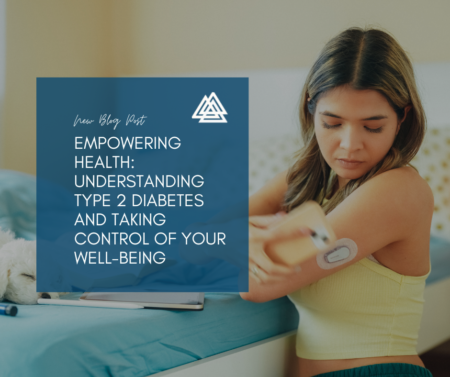 Type 2 diabetes is a chronic condition affecting millions of people worldwide. It is often misunderstood and can be overwhelming to manage. However, with the right knowledge and tools, individuals can take control of their health and lead fulfilling lives. This blog aims to provide a comprehensive understanding of Type 2 diabetes and offer practical tips for managing the condition and improving overall well-being.
Type 2 diabetes is a chronic condition affecting millions of people worldwide. It is often misunderstood and can be overwhelming to manage. However, with the right knowledge and tools, individuals can take control of their health and lead fulfilling lives. This blog aims to provide a comprehensive understanding of Type 2 diabetes and offer practical tips for managing the condition and improving overall well-being.
What is Type 2 Diabetes?
Type 2 diabetes is a metabolic disorder characterized by high blood sugar levels due to the body’s inability to use insulin effectively. Insulin is a hormone produced by the pancreas that helps glucose enter the cells to be used for energy. In Type 2 diabetes, either the body doesn’t produce enough insulin or the cells become resistant to its effects.
Symptoms of Type 2 Diabetes
The symptoms of Type 2 diabetes can develop slowly and may include:
- Increased thirst and frequent urination
- Unexplained weight loss
- Fatigue
- Blurred vision
- Slow-healing sores or frequent infections
- Tingling or numbness in the hands or feet
Risk Factors
Several factors increase the risk of developing Type 2 diabetes, including:
- Obesity: Excess body fat, particularly around the abdomen, is a significant risk factor.
- Physical Inactivity: Lack of regular exercise can contribute to weight gain and insulin resistance.
- Family History: A family history of diabetes increases the risk.
- Age: The risk of Type 2 diabetes increases with age, particularly after 45.
- Ethnicity: Certain ethnic groups, including African Americans, Hispanics, Native Americans, and Asian Americans, have a higher risk.
- Pre-diabetes: Having higher-than-normal blood sugar levels that aren’t yet high enough to be classified as diabetes.
Taking Control: Management and Prevention
Managing Type 2 diabetes effectively requires a combination of lifestyle changes, monitoring, and medication. Here are some practical steps to take control of your health:
- Healthy Eating:
- Balanced Diet: Focus on a diet rich in whole grains, lean proteins, healthy fats, and plenty of fruits and vegetables.
- Portion Control: Be mindful of portion sizes to avoid overeating.
- Limit Sugary Foods: Reduce consumption of sugary foods and beverages that can spike blood sugar levels.
- Regular Exercise:
- Stay Active: Aim for at least 150 minutes of moderate-intensity aerobic exercise per week, such as walking, cycling, or swimming.
- Strength Training: Include muscle-strengthening activities at least twice a week.
- Weight Management:
- Lose Excess Weight: If you are overweight, losing even a small amount of weight can significantly improve blood sugar control.
- Maintain a Healthy Weight: Focus on sustainable lifestyle changes rather than fad diets.
- Monitoring Blood Sugar Levels:
- Regular Checks: Monitor your blood sugar levels as advised by your healthcare provider to ensure they stay within the target range.
- Understand Patterns: Keep track of your readings to identify patterns and make necessary adjustments to your diet or medication.
- Medication and Insulin Therapy:
- Follow Prescriptions: Take medications as prescribed by your doctor. This may include oral medications or insulin injections.
- Regular Check-Ups: Schedule regular appointments with your healthcare provider to monitor your condition and adjust treatment plans as needed.
- Stress Management:
- Relaxation Techniques: Practice stress-reducing activities such as yoga, meditation, or deep breathing exercises.
- Adequate Sleep: Ensure you get enough sleep each night, as poor sleep can negatively affect blood sugar levels.
Empowering Your Well-Being
Beyond managing blood sugar levels, living with Type 2 diabetes involves fostering a holistic sense of well-being. Here are some additional tips to empower your health:
- Stay Educated: Keep yourself informed about Type 2 diabetes through reliable sources. Knowledge is a powerful tool in managing the condition.
- Build a Support Network: Connect with family, friends, or support groups who understand your journey and can offer encouragement and advice.
- Set Realistic Goals: Break down your health objectives into manageable steps. Celebrate your progress, no matter how small.
- Prioritize Mental Health: Managing a chronic condition can be stressful. Don’t hesitate to seek professional help if you feel overwhelmed.
- Embrace a Positive Mindset: Focus on what you can control and strive to maintain a positive outlook. Your attitude can significantly impact your overall health.
Type 2 diabetes is a challenging condition, but with the right approach, it is manageable. By understanding the risk factors, symptoms, and management strategies, individuals can take proactive steps to control their health and enhance their quality of life. Empower yourself with knowledge, embrace a healthy lifestyle, and seek support when needed. Remember, you have the power to take control of your well-being and thrive with Type 2 diabetes.
